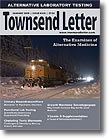Note:
Parts 1 & 2 of this series appeared in the January and
Feb/March 2006 issues of Townsend Letter.
This article (part 3) is an update of functional, predictive, sensitive,
and specific lab tests. Integrative immune system defense and repair
assessments and treatment guides are described.
Part
1 (Jan 2006): external link
Part 2 (Feb/March 2006):
coming soon

Acronyms and Abbreviations
CFIDS = chronic fatigue immune
dysfunction syndrome
d-pen = d-penicillamine provocative tests for essential and toxic
minerals,
DHEA = dehydroepiandosterone
HPA = hypothalamic pituitary adrenal feedback system
LRA by ELISA/ACT = lymphocyte response assay by enzyme-linked immunosorbed
assay & advanced cell culture based on kinase enzyme activation
MCT = medium chain triglycerides that help alkalinize the body
MELISA = modified enzyme linked immune system assay by radio-labeled
thymidine uptake
NAE = Net acid excess; reflects balance in days acid-alkaline status
NK = natural killer,
PAK = pyridoxal-alphaketoglutarate
pH = log of hydrogen ion,
POPs = Persisting organic pollutants

In previous articles in this series,
we reviewed that when healthy, we are tolerant to and resilient
in the world outside us. We are resistant to infection and recycle
any foreign antigens to which we are exposed. Our immune defense
and repair system has the dual responsibilities of protecting us
from the outside world and repairing us from daily wear-and-tear.
Capacity of the immune system is finite. Regular and substantial
exposure to environmental and food digestive remnant antigens can
overload the immune system to an extent that defense becomes the
primary role of the immune system and repair gets deferred until
the situation improves. Reliable and accurate detection of these
antigens is key to understanding the causes of autoimmune, chronic,
and degenerative illnesses as well as to assessing the functional
status of our health.1
As Bruce McEwan, a colleague from Rockefeller University, summarizes
the dual nature of stress response, "Stress protects under
acute conditions, but when activated chronically, it can cause damage
and accelerate disease." His text The
End of Stress as We Know It is recommended to those who want
a deeper understanding of stress responses and adaptation to them.
This article extends our series by looking at how what we eat and
drink, as well as what we think and do, impact our health. Emphasis
is on understanding, assessing, and getting feedback from the immune
system. This allows us to know if our immune defense and repair
system is getting the essential nutrients and other factors needed
to keep an alkaline reserve, protect from oxidative stress, and
communicate homeostatic balance in the integrated control system
known as the psycho-neuro-immuno-hormonal system. The gut and central
nervous systems are regulated through this higher, integrative control
system.
Galen and Gambino's Beyond Normality called
attention to the strengths and limits of comparing people to lab
values based on "usual" statistical ranges in the mid-70s
(Galen R, Gambino S. Beyond Normality:
The Predictive Value and Efficiency of Medical Diagnoses.
New York:Wiley; 1975). Comparing people with themselves has been
found more predictive of helpful outcomes and is fundamental to
the emerging paradigm of integrative health care. Personalized care
has stimulated development of functional metabolic, immune, hormonal,
and neurochemical tests. Integrative medicine uses these tests with
a focus on redressing causes to achieve the fullest possible health
restoration or sustained remission for each individual. More conventional
use of the tests is to assess symptomatic consequences that can
form the basis of a "symptom suppressive" care model.
This is an extension of the biochemical individuality concept developed
by Roger Williams and Emanuel Cheraskin, MD, DMD.
The Immune System
Defines Who We Are in Relation to the World Around Us
Immune system functions are so pervasive that they are fundamental
to overall health and well-being. This article emphasizes tests
and their clinical meaning as well as the essential nutrients commonly
needed to sustain healthy immune system functions. When robust and
healthy, our immune system repairs us from daily wear-and-tear,
leaving us resilient to the challenges of life. In addition, the
immune system is charged with identifying and marking for elimination
any abnormal cells that form anywhere in the body. Further, neutralizing
any foreign invader is a core responsibility for health maintenance.2
Infectious or Not,
All Foreign Invaders Are Treated the Same
All foreign invaders in the body are treated the same, which means
digestive remnants and infectious agents are dealt with identically
by the immune system; they are both "not self" and therefore
must be recycled. If first responder cells fail, if recycling becomes
overloaded, then reserve immune system components are called in
to adapt an offensive response to the invasion.3
Given that two-thirds or more of the body's entire immune system
is in the intestinal lining (or Peyer's patches, as they are known),
this suggests the importance of interactions between the gut and
the control system of the body. This also means that when our immune
system is preoccupied with digestive remnants and intestinal antigens
that enter through a "leaky" or under-repaired intestinal
wall, it is more hospitable to infectious agents to which people
are exposed. In other words, if our immune system is not able to
recycle the invader through dendritic cell actions nor neutralize
it through lymphocyte responses, the infection may be able to hijack
our energy systems to feed itself at our expense.
Autoimmune, chronic and degenerative illnesses emerge, depending
on which system or systems are most stressed. Too many depend upon
our reserve forces for daily function and survival. Examples are
given below. Restored homeostasis and sustained remission is highly
likely.4
Homeostasis First:
Effective Dendritic First Responders Protect and Defend
"Deficit in any essential nutrient
leads to dysfunction in entire system(s) that depend upon that
nutrient." Justus Baron von Leibig (1837)
"Lack of anything essential makes the whole system dysfunction."
paraphrase of von Leibig by Russ Jaffe, IAACN Annual Meeting 1990
When healthy, people have self-restoring
core systems that rebalance and keep them resilient, tolerant, and
feeling well. Known as homeostasis, this reflects our biological
bank account to which we can deposit and from which we can withdraw
until we become overdrawn. Overdrawn in this context means we are
deficient in essential nutrients, unable to detoxify internal and
external xenotoxins, or imbalanced in stress responses.
When challenged, our first responders are dendritic cells of many
subtypes, with specific dendritic cells for each specialized system
in the body along with circulating surveillance cells. Dendritic
cells protect and defend and are motile and multi-functional. They
include mast cells, monocytes, granulocytes (polys), fibroblasts,
endothelial cells lining blood vessels, Kupffer Cells in the liver,
sinusoidal cells in the spleen, astrocytes and glial cells in the
brain.5 While often under-appreciated, dendritic cells perform the
following:
1. Take up xenotoxins first to protect
more delicate systems. This also makes them exquisitely sensitive
to xenotoxin bioaccumulation.
2. Detoxify harmful chemicals in their mitochondrial cytochrome
and cytosol phase 1 & 2 detoxification systems
3. Repair basement membrane and other structural proteins, e.g.,
collagen, elastin, and related glycoproteins
4. Circulate to sense healthy and cancer cells so that the abnormal
cells can be deleted
Cancer can only occur when innate anticancer mechanisms have become
dysfunctional.
5. Have high requirements for essential nutrients that are commonly
used up and become deficient such as the following:
a. Hydration as assessed by skin pinch
and release test
b. Omega 3s (EPA, DHA, CLA) essential fatty acids with 1-3 grams
daily recommended divided among all three needed omega 3 EFAs
c. Buffering minerals, particularly magnesium, and including concurrent
choline citrate to facilitate magnesium uptake, sufficient to
keep first morning urine pH in the healthy 6.5-7.5 range (See
Figure 1)
d. Protective antioxidants such as ascorbates, based on the individual
ascorbate calibration protocol, quercetin dihydrate flavonoids
(0.5-5 gm/day), and soluble OPC flavonols (5-50 mg/day) equal
to a full day's servings of fruits and vegetables to provide ORAC
free radical protection and prevent oxidative stress
e. L-Carnitine fumarate (250-1000 mg/day) in micellized in medium
chain triglycerides to facilitate fat metabolism.
Carnitine is the shovel that brings the
fat fuel to the cell furnace in the mitochondria.
Figure 1: Influence of Choline
Citrate on Ionized Magnesium Uptake
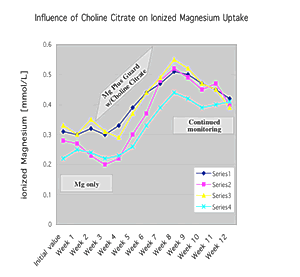
Tolerance and Homeostasis
Lost: Dendritic Exhaustion Calls for Reserve Responses
"While healthy people have a tenfold
reserve in most systems, it is increasingly easy to overwhelm
and exhaust personal health reserves."
Len Duhl, personal communication, 8/8/08
The first sign that our immune system
is wearing down is that innate immune system dendritic cells call
for reserve immune system components to mount an acquired response.
This means that repair is deferred, and foreign invasion, beyond
what can be neutralized by available dendritic cell resources, becomes
increasingly common.
Such acquired immune responses have become so common that it is
uncommon to meet someone able to reply upon their dendritic cells
for defense and repair functions without calling for antibody or
T-cell lymphocyte backup.
Functional deficits in dendritic cell action occur only when the
following take place:
1. Essential nutrients are in deficit
as outlined above and detailed below;
2. Xenotoxins, including biocides, medications, solvent residues,
and/or toxic minerals, come in beyond the adaptive capacity of
the dendritic cells to metabolize and detoxify them;
3. Learned distress has overwhelmed control system hormonal and
neurochemical balance, causing relative cortisol and adrenalin
excess.
Acquired Immune
Responses: Mucosa to Marrow
"From garden to table, from farm
to fork, we deserve safer, more nutritious, health-promoting foods."
Beatrice Trum Hunter
Nutrition for Optimal Health Association (NOHA)
Chicago, Illinois, May 1978
When dendritic cells can no longer handle
the immune systems workload, they call upon adaptive responses.
Dendritic cells process and present the foreign antigen to be reacted
against to naïve, CD3 lymphocytes. Based on the Gel and Coombs
nomenclature introduced in 1967, these can be antibody (B cell/plasma
cell, type 2) or Immune complex (type 3) or T-cell (Th1 or Th2 dominant,
type 4) responses.
Collateral Effects:
Metabolic, Hormonal, and Neurochemical
"The control system of the human
body is known as the governing vessel in traditional Oriental
medicine and the psycho-neuro-immuno-hormonal system in Western
science."
Russ Jaffe to Xing Wu and Maurice Mussat Wainright House Symposium
on Acupuncture, April 1977
Whenever immune responses are stressed,
there are consequences for the metabolic, hormonal, and neurochemical
aspects of the control system. This is because the immune, hormonal,
and neurochemical systems are parts of a common governing system
in the body. This means that anything that influences any of the
three components influences the other.
Tolerance and Homeostasis
Lost: Exhausted Dendritic Cells Call for Help from Acquired Lymphocyte
Responses
"Intolerance and hopelessness
are routed in a loss of homeostatic feedback in those who lack
the practices to restore balance when it is lost."
Bhante Dharmawara
World Future Society Meeting on Future Scenarios in Health Toronto,
Canada, 1979
When healthy, any foreign immunoreactants
or "antigens" that gain entry are promptly identified,
engulfed, and recycled by our ample supply of dendritic (phagocytic)
surveillance cells.3-6 The types of foreign antigens that the immune
system is responsible for neutralizing when we are healthy –
or addressing when our immune defenses are burdened – are
generally glycoproteins or lipoproteins and include the following:
1. Infectious agents,
2. Inhaled pollen or aeroallergens,
3. Digestive food remnants,
4. Pathogenic dysbiotic organisms and parasite antigens.
In contrast, when burdened by maldigested
antigens or antigens from dysbiotic intestinal pathogens and parasites,
our immune defenses are less able to neutralize infectious or aeroallergen
antigens and haptens.6-15 In this circumstance, our body defers
needed repair, develops inflammation as a result, and expresses
the signs and symptoms of delayed allergic autoimmune and immune
dysfunction pathologies1-6 that became, in the nineteenth century,
the basis for our descriptive, symptom-oriented, conventional health
care system.6-8
Tests of Immune
System Function and Their Clinical Meaning
"Trust yet verify"
President Ronald Reagan, 40th President of the United States
The tests described are those with the
highest predictive significance, with better sensitivity and specificity.
In general, this means the functional and person-specific tests
and assessments, as described here and in the next section. Conditions
that benefit from these tests include autoimmune, chronic, and degenerative
diseases. This includes the autoimmune conditions specific to each
part of the body before they were understood as having a common
set of causes in immune system-acquired self-attack.9
Autoimmune chronic conditions include the following:
1. Diabetes (both type 1 and type 2)
and its precursors, obesity, and metabolic syndrome
2. Rheumatoid arthritis in the joints
3. Asthma and pneumonitis in the lungs
4. Irritable bowel syndrome, regional enteritis, and ulcerative
colitis in the intestines
5. Eczema and psoriasis in the skin
6. Multiple Sclerosis in the brain
7. Uveitis in the eyes
8. Autoimmune myositis in the muscles
9. CFIDS and fibromyalgia
10. Hepatitis and other inflammations of the liver
Chronic and degenerative conditions
include the following:
1. Cardiovascular conditions, from
coronary artery diseases to atherosclerosis and arteriosclerosis
in the heart and blood vessels
2. Osteoarthritis in the joints due to cumulative repair deficits
3. Osteopenia and osteoporosis in the bones due to NAE
4. Cataracts in the eye
5. Enteropathy in the digestive track
6. Immune dysfunction syndromes
Specific tests of immune function include
the following:
1. Inflammation can be measured through
any of the inducible protein systems of the body, from Sedimentation
rate (Sed Rate), to fibrinogen, ferritin, microglobulin, prealbumin,
C-reactive protein (CRP), or tumor necrosis factor (TNF). Inflammation
is cumulative repair deficits. The more affected area of the body
is the one with the most accumulated wear-and-tear or distress.
2. Phagocytic Index for function of dendritic cells measures how
many organisms a granulocyte can engulf under standard conditions.
Healthy dendritic cells can typically take up 50 organisms per
cell.6-10,16
3. Reactive immunity is evoked when innate passive immunity based
on dendritic cells is asked to do more than they can handle:
a. Acute (type 1, immediate hypersensitivity):
IgE antibody measurable by RAST (serum) test or by skin prick
tests reflecting the histaminic, reaginic, or Ishizaka responsiveness.
This is all that conventional skin testing measures. Our experience
is that type I responses reflect overload of immune responses.
When the immune system is restored to homeostatic resilience,
type 1 reactions usually abate as IgG4 antibody levels increase
to balance the IgE.
b. Delayed late phase reactions due to reactive but not neutralizing
antibodies (type 2), immune complex (IgM anti-IgG antigen complex,
type 3), and T-cell-mediated (type 4) hypersensitivities or
delayed allergies can be best measured by functional lymphocyte
response assays such as LRA by ELISA/ACT and MELISA. They are
the current state-of-the-art tests of comprehensive delayed
hypersensitivity, delayed allergy tests for foods, and environmental
chemicals.
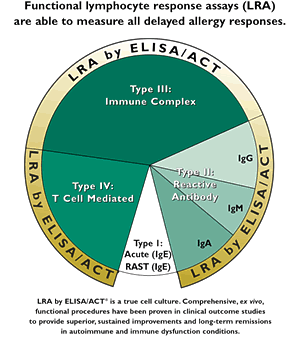
Initial antibody responses are IgM. They
are strong yet short lived, typically three to six months. In contrast,
IgG and IgA in serum and secretory IgA in mucosal secretion (sIgA)
appear months after initial antigen exposure but carry that memory
through the lifespan as long as the immune system remains healthy
and resilient.
Delayed allergy mechanisms addresses the basic burden on immune
defense and repair systems. The more attention to defensive reaction
from delayed allergies, the less ability the immune system has to
devote to necessary repair. Cumulative deferral of repair results
in increased permeability in tissues that have the greatest wear-and-tear
– those that are distressed. Cumulative repair deficits are
clinically known as inflammation. Fundamentally, we can understand
inflammation as incomplete or blocked repair.
Functional, comprehensive, ex vivo assessment of all delayed allergy
mechanisms: LRA by ELISA/ACT tests are unique in that they measure
all delayed allergy pathways. This lymphocyte response assay (LRA)
is functional. This means immune memory lymphocytes (both B- and
T-cells) respond to potential reactants under laboratory controls.
For example, beneficial, protective, neutralizing IgG antibodies
are not detected while harmful, reactive, complement-activating
IgG antibodies are detected. This is in contrast to serum ELISA
IgG or EIA tests that detect the presence of an antibody but do
not assess if the antibody function is neutralizing and helpful
or complement fixing and harmful.
The LRA by ELISA/ACT tests are comprehensive in that B-cell-mediated
antibodies, immune complexes, and T-cell-mediated reactions are
all measured. Performed in CLIA certified facilities, these assays
have exceptional reproducibility and clinical predictive significance.
Further, the LRA by ELISA/ACT tests are ex vivo in that the cells
react just as they do in the body yet under direct laboratory observation.
Reproducibility of LRA by ELISA/ACT on split samples is unusually
consistent, being greater than 98% at least to pass quality control.
With over 5,000 split samples analyzed, the consistency of the LRA
by ELISA/ACT is dramatically different from any other lymphocyte
response assay. This is because of the added improvement in signal-to-notice
ratio afforded by the novel ELISA part of ELISA/ACT, which uses
the lymphocyte as the source of enzyme amplification. Day-to-day
variations in LRA by ELISA/ACT results are greater than 97% reproducible.
This is excellent for any assay and particularly for a cell response
assay. Part of the assay robustness is due to averaging the results
from thousands of cells in the assay (data on file and available
at www.elisaact.com).
Immune System Essential
Nutrient Needs and Their Clinical Meaning
"Biochemical Individuality…
Your beautiful world within."
Roger Williams
President of the American Chemical Society Director
Clayton Medical Foundation, 1959
From antioxidants to buffering minerals,
from xenotoxins to detoxification mechanisms, from measures of net
acid excess (NAE) to digestive competence, from hormonal balance
to vitamin levels, the following tests provide essential insights
into immune system functions in humans and related higher primates,
including Orangutans and Bonobos.17
1. Ascorbate calibration as measure of ReDox,
methylation efficiency, and inflammation or repair deficit.18
Vitamin C is nature's most potent and safest antioxidant cofactor.
While it is not technically a vitamin (vital amine), ascorbate aids
in the maintenance of cellular membranes, cellular respiration,
the peroxidase cleansing system, and the restoration of vitamin
E, selenomethionine complexes, and sulfhydryl enzymes such as glutathione
synthetase, thereby helping to detoxify various drugs and chemicals.
These same systems are vulnerable to overload from environmental
chemicals that deplete essential antioxidant intermediates such
as glutathione, ascorbate, or co-enzyme Q10.
Ascorbate is also required for hormone biosynthesis and to maintain
the integrity of connective tissue, capillaries, bones, joints,
muscles, and teeth. Ascorbate is essential in wound repair and tissue
healing.
Ascorbate has been shown to increase cellular resistance to many
common viral infections (most probably due to its interferon-like
activity) and enhance specific parameters of immune function. All
these actions of ascorbate are related to its antioxidant or reducing
or electron-donating abilities. Rapid consumption of ascorbate occurs
in cells of people with chronic conditions like fibromyalgia muscle
pain, CFIDS, and other chronic immune dysfunction conditions.30
We recommend individualized calibration of ascorbate need to achieve
beneficial cellular ascorbate levels. Ascorbate calibration17
is a functional test that measures antioxidant need and turnover
and is thus a functional measure of oxidative stress. Based on ascorbate
calibration, it is evident from Figure 3 that 80% of people require
at least 10 g of ascorbate daily for optimum physiological function,
and this amount can be as high as 130g/day.
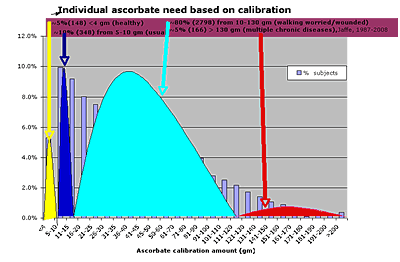
2.
D-penicillamine tests for essential and toxic minerals: measurement
of buffering minerals using such standardized and validated protocols
such as the d-penicillamine provocation tests for both essential
and for toxic minerals19 (Tables
1 and 2)
The advantage over other provocative agents is twofold:
a) Forty years of experience with the safer use of penicillamine
in treating copper mineral overload as well as for radioprotection
b) Only this assay provides information about the essential nutritional
minerals. Other agents are selective; penicillamine picks up all
divalents.
Table
1: Mineral value ranges for nutritional
and toxic minerals in second-day 24º urine after d-penicillamine
provocation, 7.5 mg./Kgm. QID for three days [N=200]
| Mineral element |
Reference Range
mg. /gm Creatinine |
Reference Range
mg. /24º sample |
Nutritional minerals
Calcium
Magnesium
Zinc
Copper
Iron
Manganese
Molybdenum
Boron
Chromium
Cobalt
Selenium
Vanadium |
310 - 620
250 - 550
0.8 - 1.3
0.04 - 0.06
0.20 - 0.30
0.005- 0.007
0.11 - 0.14
4.1 - 5.6
0.19 - 0.30
0.04 - 0.06
0.25 - 0.31
0.02 - 0.03 |
400 - 900
350 - 700
1.1 - 1.5
0.06 - 0.08
0.24 - 0.36
0.006- 0.008
0.13 - 0.19
5.8 - 6.7
0.21 - 0.33
0.05 - 0.07
0.24 - 0.35
0.03 - 0.04 |
Note: Values lower than the reference
range in provoked specimens suggests deficiency of the above needed
essential minerals. Adequacy of supplemental intake to replenish
deficits can be monitored by repeat d-penicillamine provocation
every three months.
Table 2: Toxic
Minerals
| Toxic minerals |
µg/gm Cr |
µg/24º sample |
Lead
Mercury
Arsenic
Nickel
Cadmium |
< 20
< 7
<120
< 16
< 4 |
< 25
< 9
<175
< 25
< 6 |
3. First AM urine pH for assessment of metabolic
acidosis
Eating foods that can be digested completely without triggering
local or systemic immune responses is helpful. During repair or
recovery phase, this means 80% by volume eaten of alkaline-forming
foods. These are easier to digest while providing bulk and essential
nutrients in contrast to acid-forming foods that provide dense calories
but low nutrient density.
Eating "The Alkaline Way"19 concurrently energizes
and detoxifies the body so that cell metabolic systems are restored
to their efficient, resilient states. The
chart in Table 3 of food effects on body chemistry is useful in
implementing "The Alkaline Way" in daily practice.
(coming soon...) The preferred alkaline-forming
foods are on the left side; the acid-forming foods are on the right
side.
A healthy, alkaline biochemical balance is important for all bodily
functions. A good clinical assessment of sufficiency of buffering
or of net acid excess (NAE) is attained from measurement of first
morning urine pH with a healthy range of between 6.5-7.5.20
Human cells are optimized around a narrow pH range. Even small (hundredths
of a pH unit) shifts to the acid or alkaline sides that are uncompensated
induce substantial loss of cell efficiency in energy production,
protein synthesis, essential transport, and overall metabolic competence.
Saliva is a useful tool in people with healthy gingiva. If gingiva
is not healthy, the serous fluid exudate makes saliva pH no longer
representative of NAE. Clinically, first morning urine pH is the
more reliable specimen for determining NAE.21
4. First AM urine specific gravity to assess
kidney concentrating capacity
First AM urine concentrating capacity (specific gravity) is the
best early measure of how healthy the kidneys are through measuring
their concentrating capacity. The role of the kidneys is to aid
in the clearance of toxins, toxicants, and metabolic waste. The
body excretes some of these waste molecules via urination, and the
role of the kidney is to concentrate the urine, so that such waste
molecules can be excreted with minimal loss of water and nutrients.
A urine-specific gravity of >1.02g/ml is a sign of healthy functioning
kidney tubules and glomerulae. The interpretation of other kidney
function parameters like BUN and serum creatinine is also influenced
by the specific gravity of the urine.
5. Digestive Transit time assessment via
charcoal capsules
A healthy "transit time" from food consumption through
digestion, assimilation, and waste elimination is an efficient 12-18
hour interval. We can use transit time measurements as an overall
assessment of digestive health. This can be done easily with the
use of charcoal capsules. In general, 10-12 charcoal capsules (Requa)
are taken on an empty stomach with water. The start time is noted.
When "black stuff" is noted in the stool, the completion
time is noted. The difference in hours is the transit time.22
Detailed stool digestive analysis tests are indicated if the transit
time is either too long or too short.
Restoration of digestive competence if transit time is > 18 hours
Restoration means redressing the causes of maldigestion, dysbiosis,
mucosal inflammation, and enteropathy, which includes the following:
a. Eating foods that can be more completely
digested without triggering focal or systemic immune responses
This can be based on self-tests or on comprehensive, functional
tests of food and chemical hypersensitivity such as LRA by ELISA/ACT
and MELISA.
b. Eating in ways that enhance the digestion of food to healthy
building blocks
These building blocks include amino acids, di- and tri-peptides,
sugars, glycerides, and fatty acids.
c. Replenishing a probiotic healthy microflora with 20-40 Bn viable
organisms daily
A full range of healthy probiotics is needed along with dietary
or supplemental prebiotics. Prebiotic fiber, 40-100 gm/day, is
preferred in the 80% soluble and 20% insoluble proportion; beta-glucan-rich
forms are able to bind and remove toxins while nourishing the
probiotic beneficial organisms.
d. Stimulating repair of intestinal capacity and rebuilding areas
of focal intestinal atrophy (enteropathy), which means providing
energy for repair from l-glutamine (best recycled with the benefit
of PAK [pyridoxal-alpha-ketoglutarate] to avoid glutamine build-up
outside cells as excitoneurotoxins). This also means enhancing
efficient removal of environmental toxins, from toxic minerals
to hormone mimic biocides to solvent residues. This has the benefit
of staying within physiologic levels and avoiding glutamate build-up
outside nerve cells.
We suggest 1.5 gm l-glutamine combined with 0.5 gm PAK taken on
rising and before bed on any empty stomach. Additional doses can
be beneficial 30-60 minutes before exercise or "work-outs."
Note that adding pyridoxine (B6) to alphaketoglutarate does not
work as an alternative.
e. Secretory IgA (sIgA) as measure of mucosal immune status
Atrophy of intestinal wall surface area and diminished healthy
intestinal mucosal immune defense mucins and secretory IgA antibodies
are among the functional losses of immune status. If transit time
is shorter than 12 hours, hypermotility and attended decreases
in nutrient uptake should be investigated.21
6. Vitamin Profile
to include the following:
a. Vitamin A, retinols in plasma,
b. Vitamin Bs by enzyme kinetic assay in whole blood,
c. Vitamin C by oral ascorbate calibration,
d. Vitamin D or 25OH-cholecalciferol in plasma
e. Vitamin E or tocopherols in plasma and oxidized LDL in urine,
f. Fatty acid analysis from red cell membranes, analyzed at the
Kennedy-Krieger Lab of Johns Hopkins University,
g. Iron, TIBC, and ferritin in serum.
7. Adrenal / HPA
Axis assessment of hormone rhythm and balance: free cortisol / DHEA
(saliva or plasma taken on rising, mid-day, late afternoon, and
before bed to assess adrenal response.
In a recently concluded assessment, we were able to show
improved adrenal stress indices (ASI) after just six weeks on a
unique, comprehensive combination of Rhodiola, Phellodendron, Magnolia
micellized in perilla oil, and MCT. This improvement occurs sooner
than in most hormone studies, which require six months or more to
show benefits.23 Striking improvement in glucose/insulin
energy regulation concurrent with improved HPA axis (cortisol/DHEA)
function was also observed in our studies confirming the direct
link between adrenal fatigue (cortisol / DHEA dysrhythm) and glucose
/ insulin energy regulation (Figure 4).23,24
Figure 5 illustrates a case example
wherein improvement in the cortisol DHEA ratio coincided with glucose
and insulin regulation.
Figure 4: Effect
on Mean Cortisol Values for Complete Group
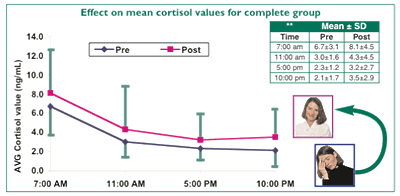
Figure 5:
"DG": Improvement in Better Insulin
Function with Improved HPA Axis
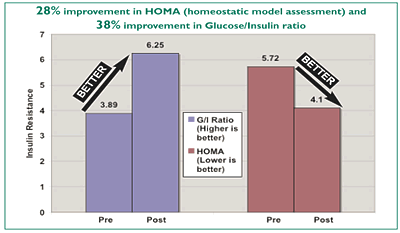
8. Thyroid hormone
function tests: Free T3, Free T4, and TSH to assess thyroid hormones
plus anti-thyroid antibody studies if thyroiditis is suspected
Healthy TSH is 0.5-2.5 IU/ml. Autoimmune thyroiditis is increasingly
recognized and appears to be more common in people with thyroid
dysfunction in the twenty-first century than in the twentieth century.
9. Oxidative Stress and methylation: Homocysteine
(healthy values are < 6 mg/dl in plasma) and oxidized cholesterol,
oxidized LDL, and 8-oxo-guanine are undetectable in healthy urine
because of antioxidant protection and thus lack of oxidative damage.
10. Detoxification
pathways can be measured via their products.
Hippurates reflect glycine status; glucarates reflect d-glucaric
acid conjugation; mercapturates reflect thiol or cysteine conjugation;
sulfates are an additional detoxification conjugation pathway. These
different mechanisms for making toxins more water-soluble and less
generative of free radicals are our detoxification systems.
Sulfites (urine) are not present in healthy people. Sulfite presence
in the urine reflect molybdenum deficit, as the sulfite oxidase
enzyme is molybdenum-dependent.

Case Example
WC was a typical 50-year-old, a successful Latino male teacher,
father of five (four living), who presented with a long history
of labile hypertension, intermittent sleep and mood disorders, and
an anxiety about his future. The medical, social, environmental,
and family histories were unremarkable.
Self tests revealed the following:
1. First AM urine pH was consistently
5-6, despite following an alkaline way diet for three months.
2. Transit time was observed at 136 hours. Follow-up comprehensive
stool digestive analysis revealed dysbiosis (three pathogens,
sensitive to garlic and ginger), maldigestion particularly of
fats and protein, as well as evidence of enteropathy and altered
mucosal uptake as a consequence.
3. Ascorbate calibration determined that 30 grams were needed
to calibrate. Weekly calibrations were repeated while he maintained
a daily intake at 75% of calibration amount to satisfy daily needs.
4. D-penicillamine provocation tests for nutritional and toxic
minerals revealed a deficit in magnesium and an excess of arsenic
and lead. Biological detoxification was carried out and d-penicillamine
added on Monday and Thursday for three months at 7.5 mg/kgm QID.
In addition, ionized magnesium salts and choline citrate were
given (three to six doses daily) to restore and maintain first
AM urine pH in the healthy 6.5-7.5 range.
5. LRA by ELISA/ACT tests were performed. Reaction to propyl gallate,
gluten, and sulfite were found. After careful counseling about
hidden sources and exposures to reactive items, WC agreed to substitute
for reactors for six months, following an immune-tolerance resetting
program as part of his healing.
Based on the above tests and self-assessments,
WC was started on comprehensive supplementation to improve magnesium
uptake through concurrent choline citrate administration, adrenal,
digestive prebiotic and probiotic flora as well as recycled glutamine
to stimulate repair. Detoxification assessment revealed selective
deficit in mercapturates. Increase in sulfur-rich foods were then
included including daily choice of one or more of ginger, garlic,
onions, brassica sprouts, and eggs.
Over a six-month period, WC found himself more resilient, reported
improved restorative sleep, and was more hopeful about his life.
Follow-up tests revealed the following:
1. First AM urine pH returned to and
remained in the goal range of 6.5-7.5.
2. Transit time improved to 24 hours.
3. Ascorbate calibration reached a peak value of 50 grams after
two months and had reduced to 12 grams by the end of six months.
4. D-penicillamine provocation showed the magnesium deficit had
been corrected and that lead and arsenic were no longer detectable
although increase in cadmium excretion was observed and detoxification
continued for another six months.
5. LRA by ELISA/ACT tests revealed loss of reactivity to gluten
and sulfite. Continued reactivity to propyl gallate was observed.
On investigation, certain personal care products containing propyl
gallate were found and discontinued; products not containing this
chemical were substituted.
WC reported that he had lost 19 pounds
without caloric restriction. He also reported himself to be more
at ease and less reactive to stressful situations. Overall, he reported
that he felt 10-15 years younger and was able to exercise more "because
I feel so much better."
Conclusion
Each person has a specific set of conditions and requires nutrients
at dosages to best meet their individual utilization rates or half-lives.
The information above provides functional, state-of-the-art methods
for determining individual needs based on causes rather than consequences.
This makes it possible for people to take a more active role in
their health and have actionable information available to them,
particularly with the experience and interpretation provided by
knowledgeable health professionals.24-31 We can now use integrative
medical approaches based on global evidence databases and clinical
experience as detailed in this article. This article is dedicated
to those who want to live well and happily.

Resources
LRA by ELISA/ACT® tests are available from
ELISA/ACT Biotechnologies, LLC
46161 Westlake Drive, #300A, Sterling, Virginia 20165
800-553-5472; Fax: 703-450-2981
clientservices@ELISAACT.com
| www.ELISAACT.com
MELISA Medica – Prof. Vera Stejskal
August Wahlstöms väg 10
182 31 Danderyd, Sweden
Phone & fax +46 8753 2322
contact@melisa.org
The Health Studies
Collegium Alkaline Way™ Guide
is available in print and digital versions. Contact:
2 Pidgeon Hill Drive, # 410; Sterling, Virginia 20165
800-328-7372; Fax: 703-450-2997
PERQUE™ Supplements are available
from PERQUE, LLC
14 Pidgeon Hill, #180; Sterling, Virginia 20165
800-525-7372; Fax: 703-450-2995
clientservices@PERQUE.com
| www.PERQUE.com
Kennedy-Krieger Lab of Johns Hopkins
University
707 North Broadway, Baltimore, Maryland 21205
443-923-9200; 800-873-3377
info@kennedykrieger.org
| www.kennedykrieger.org
Notes
1. Jaffe R. Functional lab tests to evaluate immune competencies
in chronic illness and chronic infection: Part 1. Townsend
Letter 2006; Jan; 87-89.
Part 2. Feb/Mar;107-109.
2. Austyn JM, Wood KJ. Principles
of cellular and molecular immunology.
London: Oxford University Press; 1999; 278-288, 492-494.
3. Cohen IR. The self, the world, and autoimmunity. Sci
Amer. 1988; 258:52-60.
4. Prodeus A, Goerg S, Shen L-M, et al. A critical role for complement
in maintenance of self-tolerance. Immunity.
1998; 9:721-731.
5. Janeway C. Immunobiology.
New York: Garland Pub; 2001.
6. Lipski L. Digestive Wellness.
3rd ed. New York: McGraw-Hill; 2004.
7. Read NW. The relationships between colonic motility and transport.
Scand J Gastroenterol Suppl.
1984;93:35-42.
8. Ikeda Y, Akbar SM, Matsui H, Onji M. Antigen-presenting dendritic
cells in ulcerative colitis. J Gastroenterol.
2002; 37 Suppl 14:53-55.
9. Kobayashi N, Goto J. Noncompetitive immunoassays for small molecules
(haptens) with high sensitivity and specificity. Adv
Clin Chem. 2001; 36:139-170.
10. Chaitow L. Probiotics: The friendly bacteria. Integrative
Medicine. Health World [online
press]. 1996.
11. Biesbrock A R, Reddy M S, Levine M J. Interaction of a salivary
mucin-secretory immunoglobulin A complex with mucosal pathogens.
Infect. Immun.
1991; 59: 3492-3497.
12. Ammann AJ Hong R. Selective IgA Deficiency and Autoimmunity.
Clin Exp Immunol.
1970; 7:833-838.
13. Ammann AJ Hong R. Selective IgA deficiency: Presentation of
30 cases and a review of the literature. Medicine.
1971; 50:223-236.
14. Ogra P L, Mestecky J, Lamm M E, Strober W, McGhee J R, Bienenstock
J, eds.Handbook of Mucosal Immunity.
New York: Academic Press; 1994.
15. Pabst R. The anatomical basis for the immune function of the
gut. Anat Embryol (Berl).
1987; 176(2):135-144.
16. Matsunaga T, Rahman A. In search of the origin of the thymus:
the thymus and GALT may be evolutionarily related. Scand
J Immunol. 2001; 53(1):1-6.
17. KiamaSG, Cochand L, Karlsson L, Nicod LP, Gehr P. Evaluation
of phagocytic activity in human monocyte-derived dendritic cells.
Journal of Aerosol Medicine.
September 1, 2001; 14(3): 289-299.
18. How to do an ascorbate (vitamin C) calibration protocol ("C
Flush") to determine individual, functional need for ascorbate.
Available at: http://www.perque.com/pdfs/Pt_Ascorbate_Slush_FIN.pdf.
Accessed October 27, 2008.
19. ASIMP working group on toxic minerals, d-penicillamine protocol
(based on Jaffe) for determining toxic and nutritional mineral status
by provocation into the urine. Health Studies Collegium, Sterling,
VA 20165.
20. The Joy of Food: The Alkaline
Way Guide. Sterling, Virginia:
Health Studies Collegium; 2008.
21. 1st morning urine pH after rest. PERQUE,LLC, Sterling, VA 20165.
22. Transit Time: Digestion Evaluation. PERQUE, LLC, Sterling, VA
20165.
23. www.PERQUE.org/pdfs/PQ_StressFatigueAdrenals%5B6%5D.pdf
(Note: 01/09, link is now http://www.perque.com/pdfs/PQ_StressFatigueAdrenals%5B6%5D.pdf
)
24. Jaffe R, Mani J. Improved cortisol/DHEA rhythm and glucose/insulin
function after brief (6 week) supplementation with an adaptogenic,
trophorestorative supplement, in preparation.
25. Bell J, Whiting SJ. Personal communication via Dr. Susan Brown,
12 October 2000.
26. Guyton AC, Hall JE. Textbook
of Medical Physiology. 10th
ed. Philadelphia: W B Saunders; 2000.
27. Lemann J Jr, Bushinsky DA, Hamm LL. Bone buffering of acid and
base in humans. Am J Physiol Renal
Physiol. 2003 Nov; 285(5):F811-32.
28. Lehninger AL. Bioenergetics: The
Molecular Basis of Biological Energy Transformations.
3rd ed. Reading, MA: Addison-Wesley Publishing;1978.
29. Navazesh M, Denny P, Sobel S. Saliva: A fountain of opportunity.
Tex Dent J.
2003: 120(5):424-432.
30. Bertzbach K. Immunopathology and peridontal diseases. A review
and an attempt at site determination.
Dtsch Zahnarztl Z. 1975;
30(7):426-430.
31. Jaffe R. First-line comprehensive care iii update on immune
system lab tests for fibromyalgia-chronic fatigue-metabolic syndrome:
continuum of treatment-resistant pain and fatigue: optimum clinical
management improves outcomes and reduces risks and treatment complications
as supported by new data. Townsend
Letter. 2008; Jan: 87-94.
|



![]()
![]()
![]()
